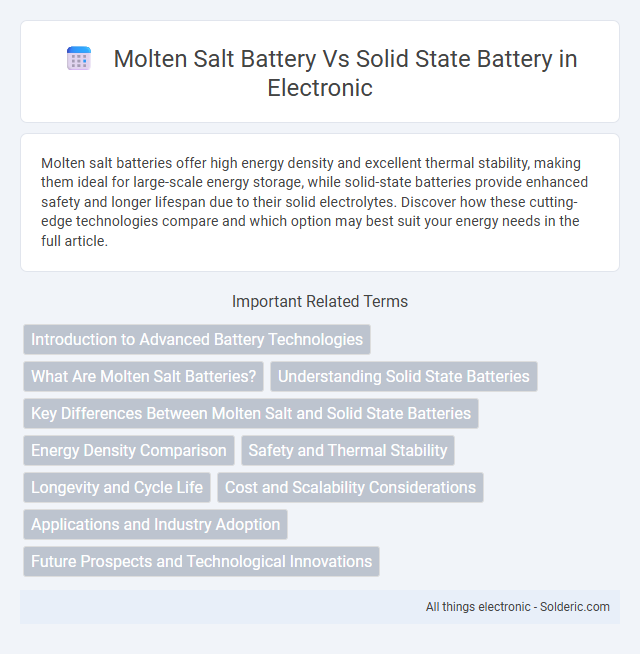Molten salt batteries offer high energy density and excellent thermal stability, making them ideal for large-scale energy storage, while solid-state batteries provide enhanced safety and longer lifespan due to their solid electrolytes. Discover how these cutting-edge technologies compare and which option may best suit your energy needs in the full article.
Comparison Table
| Feature | Molten Salt Battery | Solid State Battery |
|---|---|---|
| Electrolyte Type | Molten salt (liquid at high temp) | Solid ceramic or polymer |
| Operating Temperature | High (typically 300-700degC) | Low to moderate (room temp to ~100degC) |
| Energy Density | Moderate (~100-150 Wh/kg) | High (~250-500 Wh/kg) |
| Safety | Risk of leakage, thermal runaway at high temp | Enhanced safety, non-flammable solid electrolyte |
| Cycle Life | Good (1,000-2,000 cycles) | Excellent (2,000+ cycles) |
| Cost | Moderate, requires heat management systems | Currently high due to manufacturing complexity |
| Applications | Grid storage, stationary energy storage | Electric vehicles, portable electronics |
| Charge/Discharge Rate | Moderate to slow | Fast charging capability |
Introduction to Advanced Battery Technologies
Molten salt batteries utilize high-temperature liquid electrolytes, enabling exceptional energy density and thermal stability for grid-scale energy storage. Solid-state batteries replace liquid electrolytes with solid materials, offering enhanced safety, longer cycle life, and higher energy density ideal for electric vehicles and portable electronics. Both technologies represent cutting-edge advancements in energy storage, addressing limitations of conventional lithium-ion batteries in performance and safety.
What Are Molten Salt Batteries?
Molten salt batteries utilize a liquid salt electrolyte that operates at high temperatures, enabling efficient ion conduction and high energy density. These batteries are known for their thermal stability and long cycle life, making them suitable for large-scale energy storage applications. Unlike solid-state batteries, which use a solid electrolyte to improve safety and energy density, molten salt batteries rely on heat to maintain the electrolyte in a molten state.
Understanding Solid State Batteries
Solid state batteries use a solid electrolyte instead of a liquid or molten salt, offering enhanced safety by reducing the risk of leaks and fires. Their higher energy density and improved thermal stability make them ideal for electric vehicles and portable electronics. Molten salt batteries, while offering good ionic conductivity at high temperatures, lack the room temperature performance and safety advantages inherent to solid state technology.
Key Differences Between Molten Salt and Solid State Batteries
Molten salt batteries use high-temperature molten salts as electrolytes, enabling high energy density and thermal stability, while solid state batteries employ solid electrolytes that offer enhanced safety and longer cycle life. Molten salt batteries typically operate at elevated temperatures, making them more suitable for large-scale energy storage, whereas solid state batteries function efficiently at room temperature with faster charge times and compact design. Your choice between the two depends on application priorities such as energy density, operating conditions, and safety requirements.
Energy Density Comparison
Molten salt batteries typically offer higher energy density at elevated temperatures, making them ideal for large-scale energy storage with energy densities around 150-250 Wh/kg. Solid-state batteries promise even greater energy densities, potentially exceeding 400 Wh/kg, due to their use of solid electrolytes enabling closer electrode packing and improved safety. The energy density advantage of solid-state batteries supports applications in electric vehicles and portable electronics where weight and volume are critical.
Safety and Thermal Stability
Molten salt batteries exhibit high thermal stability due to their use of liquid electrolytes that operate at elevated temperatures, reducing risks of thermal runaway and enhancing safety in extreme conditions. Solid state batteries employ solid electrolytes that are inherently non-flammable, offering superior safety by eliminating leakage and dendrite formation, which are common in liquid electrolyte systems. Your choice should consider that while molten salt batteries excel in high-temperature environments, solid state batteries provide safer, more stable performance at typical operating temperatures.
Longevity and Cycle Life
Molten salt batteries exhibit high thermal stability and can endure thousands of charge-discharge cycles, enhancing longevity in high-temperature environments. Solid state batteries offer longer cycle life due to their stable solid electrolytes, which reduce dendrite formation and degradation over time. Both technologies surpass conventional lithium-ion batteries in durability, with solid state batteries showing particular promise for extended lifespan in consumer electronics and electric vehicles.
Cost and Scalability Considerations
Molten salt batteries generally offer lower material costs due to the abundance of readily available salts and simpler manufacturing processes, making them more scalable for large-scale energy storage solutions. Solid state batteries involve expensive materials like lithium metal and require advanced fabrication techniques, which increase production costs and limit scalability at present. Your choice depends on balancing initial investment against long-term benefits, with molten salt batteries favoring cost-effective expansion and solid state batteries promising higher energy density for future applications.
Applications and Industry Adoption
Molten salt batteries are predominantly used in large-scale energy storage systems for renewable energy integration due to their high energy capacity and thermal stability. Solid-state batteries are gaining traction in the electric vehicle industry and portable electronics for their enhanced safety, higher energy density, and faster charging capabilities. While molten salt technology is favored in grid and industrial applications, solid-state batteries are seeing rapid adoption in consumer electronics and automotive sectors.
Future Prospects and Technological Innovations
Molten salt batteries exhibit promising future prospects due to their high energy density, thermal stability, and ability to operate at elevated temperatures, making them ideal for large-scale energy storage and grid applications. Solid-state batteries are advancing rapidly through innovations in solid electrolytes, such as sulfide and oxide materials, which enhance safety, increase energy density, and improve charging speeds, positioning them as key contenders for electric vehicle and portable electronics markets. Emerging hybrid designs integrating molten salt electrolytes with solid-state components aim to leverage the advantages of both technologies, driving breakthroughs in battery lifespan, efficiency, and environmental sustainability.
Molten salt battery vs solid state battery Infographic

 solderic.com
solderic.com